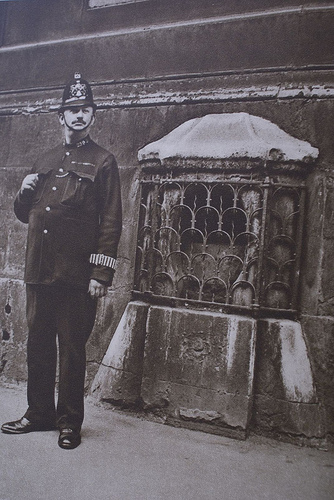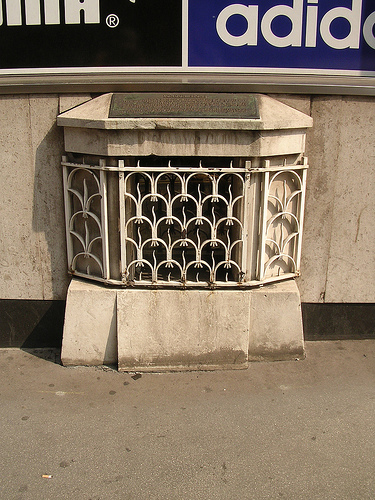« And some talented. | Main | London Stone -- Part II »
March 04, 2010
The London Stone: 111 Cannon Street

After finishing up at Stanford last year, Holden Oliver had a few drinks and ran amok in Legal London. Then he got dressed up like an early 20th century bobby for no reason at all. Here he poses before the mysterious London Stone on Cannon Street.
Finding the Stone is not hard:
You head east, down Fleet Street, past Dr. Johnson's house, past St. Paul's a block north, staying on Fleet Street (not Lane) which becomes Ludgate Hill (past intersection with Old Bailey), which becomes Cannon Street, to 111 Cannon, across from the tube station. You'll miss It if you're not careful.
You may give an oath to It if you like. Make a wish. Maybe lay a curse on someone.
I have a thing about The London Stone--probably because I live much of the time in California in an "old" 22-year-old home. Back East (and even in the Midwest where I did most of my growing up), there's much older stuff, of course.
Sometimes in more civilized regions of America--generally on the east coast--a house, street or grave will date back to the 1600s. But it's nothing like you stumble upon at every turn at every moment in London. In America, out West, and very close to my home in California, you can see rock and cave paintings. In the American Midwest and South, there are mound-builder mounds and other antiquities.
But these don't cut it for me. I like old books, old homes, old anythings; however, they need to be the relics of my cruel, greedy, goofy-looking European ancestors.
(I am sorry. Do feel free to alert the Oberlin College faculty, and the BIA. Maybe Keith Olbermann's having a slow day.)
The London Stone is important to me because it's mysterious and fires the imagination--not because it's way old. There's a myth that the Stone was part of an altar built by Brutus of Troy, the legendary founder of London. Not true in any respect. But the Stone is Olde, older than Boudica, Tacitus, Disraeli or Keith Richards, and at the very minimum, an enduring symbol of the Authority of The City since London Roman times.
So we're talking about at least 2000 years of Stoneness. Some scholars think 3000 years.
My guess: it's been a human mile marker, altar and/or symbol of London for about 2200 years--even before the brilliant Roman cad Julius Caesar blew into Britain in 54 BC and again the following year as a military pretext to further his political ambitions.

Posted by JD Hull at March 4, 2010 11:59 PM
Comments
Is there stone behind the grate? You really cannot see much behind from these photos.
Posted by: Joseph Marchelewski at March 4, 2010 01:17 AM
Joseph-Yes. But to really see it you have to go both outside and inside the little store pictured on Cannon Street (on north side of street--if you are, say, walking east to Tower of London area). It's encased in a heavy glass or plastic. About knee-high. You see another side of it from inside the store. For 2000+ years London has built around it. It's pretty much stayed-put except during WWII when bombing dislodged and threw it into the street a few yards.
See book "London: The Biography" (2000) by Peter Ackroyd.
Posted by: Holden Oliver (Kitzbühel Desk) at March 4, 2010 01:15 PM
Hello, there is a photo of the stone behind the grating here
http://www.megalithic.co.uk/article.php?sid=8349
Posted by: Andy Burnham at March 5, 2010 03:37 PM